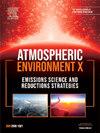模拟和实验PM10源对绘制源特异性氧化电位的贡献比较
IF 3.4
Q2 ENVIRONMENTAL SCIENCES
引用次数: 0
摘要
要有效减轻颗粒物污染造成的健康负担,就需要比单独的颗粒物总质量更直接地与有害健康影响挂钩的指标。氧化电位(OP) - PM根据其化学成分诱导氧化应激的能力-正在被公认为与健康相关的指标。将现场测量的特定源OP值集成到化学传输模型(CTMs)中,可以绘制具有广泛时空覆盖范围的特定源OP。关键的一步是确保ctm推导和基于观测的源贡献之间的一致性。本研究利用法国15个站点(2013-2016)的PM10数据,评估并优化了lotos - euro CTM和正矩阵分解(PMF)源剖面之间的一致性。虽然PM10总量与观测值有一定的相关性(r2 = 0.35-0.66),但不同源类型和位置的源特异性比较有所不同。住宅生物质燃烧(r2 = 0.34-0.75)、二次无机气溶胶(r2 = 0.30-0.71)和海盐(r2 = 0.18-0.71)的结果令人满意,而道路交通表现出较弱的一致性(r2 = 0.01-0.40)。利用优化的源匹配,生成了法国上空的OP地图,显示人为源对OP的贡献大于PM10质量。该研究强调了在匹配CTM和PMF源进行OP建模的关键挑战,因为次要气溶胶形成、PMF剖面中的源混合以及时空表征差异。完善排放数据,在CTMs中纳入二次有机气溶胶和老化过程,并扩大特定来源的OP测量,特别是对农业等未表征来源的测量,被认为是必不可少的下一步。尽管目前存在局限性,但这种方法为推进以健康为导向的空气质量管理提供了一个有希望的框架。本文章由计算机程序翻译,如有差异,请以英文原文为准。
Comparison of modelled and experimental PM10 source contributions for mapping source-specific oxidative potential
To effectively reduce the health burden of particulate matter (PM) pollution requires indicators more directly linked to adverse health effects than total PM mass alone. Oxidative potential (OP)—the ability of PM to induce oxidative stress based on its chemical composition—is gaining recognition as a health-relevant metric. Integrating source-specific OP values from field measurements into Chemical Transport Models (CTMs) enables the mapping of source-specific OP with broad spatiotemporal coverage. A critical step is ensuring alignment between CTM-derived and observation-based source contributions.
This study evaluates and optimises the consistency between the LOTOS-EUROS CTM and Positive Matrix Factorization (PMF) source profiles, using PM10 data from 15 French sites (2013–2016). While total PM10 shows reasonable correlation with observations (r2 = 0.35–0.66), source-specific comparisons vary across source-types and locations. Promising results are obtained for residential biomass burning (r2 = 0.34–0.75), secondary inorganic aerosols (r2 = 0.30–0.71), and sea salt (r2 = 0.18–0.71), whereas road traffic shows weaker alignment (r2 = 0.01–0.40). Using the optimized source matching, OP maps are generated over France, showing stronger contributions from anthropogenic sources to OP than to PM10 mass. The study highlights key challenges in matching CTM and PMF sources for OP modelling, due to secondary aerosol formation, source mixing within PMF profiles, and spatiotemporal representation differences.
Refining emission data, incorporating secondary organic aerosol and aging processes in CTMs, and expanding source-specific OP measurements, particularly for uncharacterized sources like agriculture are identified as essential next steps. Despite current limitations, this approach offers a promising framework for advancing health-oriented air quality management.
求助全文
通过发布文献求助,成功后即可免费获取论文全文。
去求助
来源期刊

Atmospheric Environment: X
Environmental Science-Environmental Science (all)
CiteScore
8.00
自引率
0.00%
发文量
47
审稿时长
12 weeks
 求助内容:
求助内容: 应助结果提醒方式:
应助结果提醒方式:


